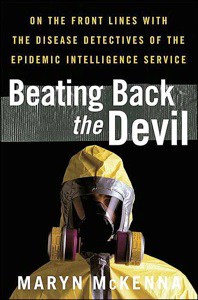BEATING BACK THE DEVIL: On The Front Lines with the Disease Detectives of the Epidemic Intelligence Service
Author's Notes
 The Centers for Disease Control and Prevention, the disease-detective agency of the U.S. government, has an outsize reputation. Its acronym is internationally famous; ministries of health in several different countries have named their public health divisions "the [fill in the blank] CDC" in tribute, even when the initials mean nothing in that country's language.
The Centers for Disease Control and Prevention, the disease-detective agency of the U.S. government, has an outsize reputation. Its acronym is internationally famous; ministries of health in several different countries have named their public health divisions "the [fill in the blank] CDC" in tribute, even when the initials mean nothing in that country's language.
So when I began covering the CDC in 1997 for the Atlanta Journal-Constitution, I was surprised to find the glamour masked a gritty reality. The agency lacked almost all of the glossy accoutrements of high-level science. Its labs were outdated and some of its offices were literally crumbling; on one campus, a freezer had fallen through the floor of the 50-year-old building where it had been stashed.
But despite those conditions—or maybe because of them—the staff of the CDC possessed a fierce esprit. They could claim accomplishments that belonged in history books. They had helped eradicate smallpox, the only disease yet vanquished by mankind, and suppressed measles and polio worldwide. They had drawn the first associations between environmental lead exposure and learning disabilities, and between cancers and some industrial chemicals. They had made the initial identification of Legionnaire's disease, toxic shock syndrome, and even AIDS.
I found the focus of that esprit, the place where enthusiasm and dedication burned bright and stayed up late, in the Epidemic Intelligence Service, a group with a name so perfect it sounded fictional. The EIS, though, is entirely real. It is the disease-detective agency's rapid-reaction force, a corps of just-out-of-training doctors, PhDs and other health professionals who are dispatched with little notice to disease outbreaks and other health problems around the world.
I heard about the EIS almost as soon as I began going to the CDC. It has 2,700 living alumni who love to tell stories about their investigations. And there were a lot of investigations, almost 10,000 since the group was founded in 1951.
But I truly saw the corps in action in the fall of 2001. The World Trade Center was attacked on Sept. 11; the first anthrax case was divulged on Oct. 4. Almost the entire EIS—every member who could travel and was not already trapped overseas by the shutdown of U.S. air service—scrambled in response.
The CDC allowed me to go inside the team that was investigating the anthrax-loaded letters sent to Congress. I was struck by their dedication—during the crisis their workdays were never shorter than 16 hours—by their grace under extraordinary political and media pressure, and by the passion they showed for deploying the skills they had trained so hard to learn.
The anthrax attacks made concrete something that had always been acknowledged as theoretical: The United States is vulnerable to biological attack. Since 2001, the CDC has received more funding from Congress. EIS officers have been placed in many state health departments.
In 2002, I began shadowing the first group of EIS members to come to the CDC with the knowledge that combating bioterrorism—as well as countering disease outbreaks—would be part of the job from now on. BEATING BACK THE DEVIL tells the history of the EIS, and the story of that year.




